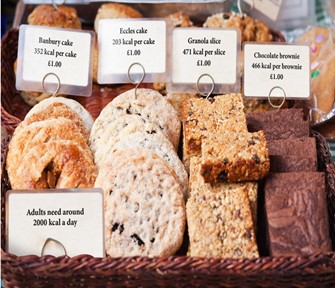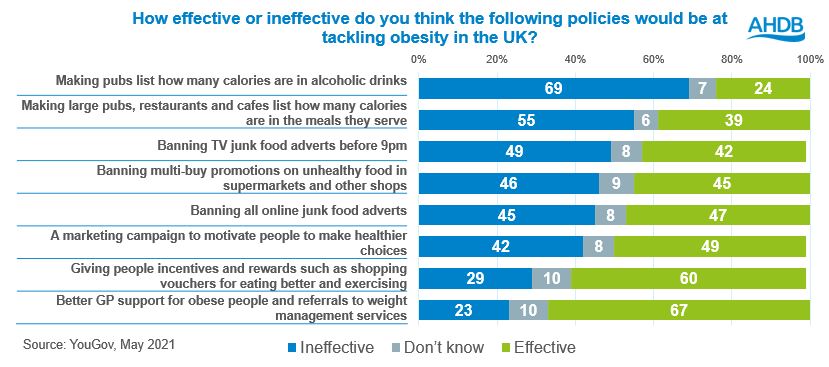Calories on menus polarise opinions
Friday, 1 October 2021
New regulations from the government, set to be introduced in April 2022, requires restaurants, cafés and takeaways in England with 250 or more employees to list calorie counts on non-prepacked food and soft drinks.
Calorie information will need to be displayed at the point of choice for the customer, such as physical menus, online menus, food delivery platforms or apps and food labels.
This forms part of the government’s obesity strategy, which aims to help people make more informed and healthy choices. New information from the government, released on 17 September 2021, outlines how this will be implemented.
What do consumers think?
Research from YouGov suggests that public opinion is divided on whether calories on menus will be effective at tackling obesity within the UK, with 55% saying they think it would be fairly or very ineffective and 39% saying they believe it would be fairly or very effective.
Having better GP support and referrals was viewed by consumers as the most effective policy to tackle obesity in the UK, while calories on alcoholic drinks was viewed as the least effective.
The proposal to include calorie counts on menus has been a controversial idea with many claiming it could do more harm than good.
While 40% believe it could encourage people to eat healthier, 24% believe it could have a negative impact on those with eating disorders. This number is much higher for ages 18-24, with 48% saying they believe the policy will have a negative impact on those with disordered eating (YouGov, May 2021).
Some companies and restaurants already include the number of calories on menus, such as McDonalds. Lumina Intelligence research shows that 1.9% of main dishes had a low calorie claim in 2020 spring/summer menus, showing this isn’t currently something which is widely used within the foodservice sector.
Studies on whether calories on menus had an impact on the amount ordered by consumers are mixed, but research from Harvad University in 2019 and published in the British Medical Journal suggests that calories on menus reduced consumption by 60 calories on average.
Regulations explained
There was much speculation about what the regulations would contain before the government released the information on 17 September. Calories can be calculated in a laboratory but they don’t need to be, with several other methods which can be used to save time and money. The enforcement will also allow a leeway of plus or minus 20 per cent on the value of calories in each dish or item.
While these regulations are applicable to much of the foodservice sector, there are some notable exceptions to these regulations:
- in-house mass catering such as workplace canteens, educational facilities, hospitals and care homes
- foods which are not sold as part of a meal for example loose fresh fruit or a loaf of bread
- foods which are only on menus for less than 30 days per year
- Alcoholic drinks over 1.2% ABV
Businesses selling food in scope of the regulations must:
- display the energy content of the food in kilocalories (kcal)
- reference the size of the portion to which the calorie information relates – e.g. calories per one slice of cake or calories to be shared between 2-3 people
- display the statement that ‘adults need around 2000 kcal a day’ (for the purposes of this guidance, this statement will be referred to as the ‘statement of daily calorie needs’)

Source: Department for health and social care – calorie labelling – annex C
How are the calories counted?
The calorie content displayed should be calculated using one of the following three methods:
- the manufacturer’s analysis of the food
- a calculation from the known or average values of the ingredients used – for example a sandwich could be calculated by adding together the calories in the bread, butter and filling
- a calculation from generally established and accepted data (in the UK this usually refers to the McCance and Widdowson’s Composition of Foods dataset; other established data may be more suitable for imported foods, for example EuroFIR or USDA Food Composition Data may be more appropriate for foods imported from the United States)
McCance and Widdowson’s 'composition of foods integrated dataset' on the nutrient content of the UK food supply has the calorie values for 100g for 2,887 food and drink products.
A combination of these methods is permissible for the same menu, or even the same product if it is made up of different constituent parts.
For example, to calculate the calories in a dish containing a grilled lamb steak with new potatoes, peas and mint sauce. From McCane and Widdowson’s we can see that a grilled lean lamb steak on average has 198kcal/100g and potatoes, new and salad, boiled in salted water, flesh and skin has 68kcals/100g. If the supplier says the peas are 79kcals/100g and the mint sauce comes with a label saying 98kcals/100g, we can combine all these together to give a final total.
So if the lamb leg steak was 150g, 200g of potatoes, 120g of peas and 20g of mint sauce, we can calculate that the dish would contain 549kcals.
These regulations will be enforced by local authorities who have discretion in how they are implemented. They recognise that methods to assess the accuracy of calorie content, such as laboratory analysis, may be expensive and a burdensome method to assess compliance. Plus or minus 20% of the actual total or what an officer may consider feasible would be allowed.
Topics:
Sectors:
Tags:



